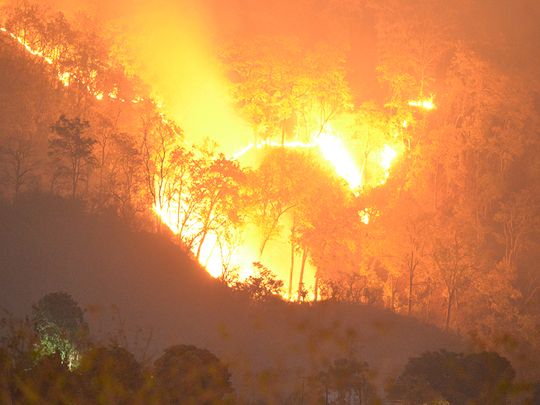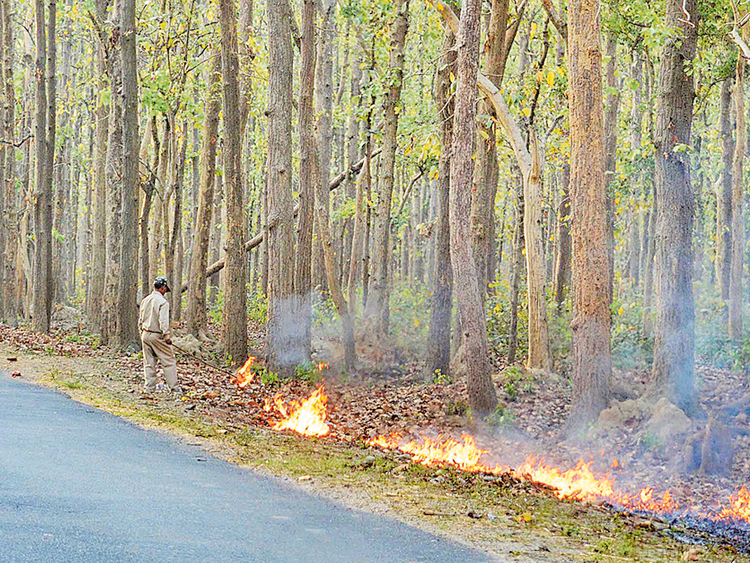
Dubai: The ‘lungs’ of India are burning. Hundreds of hectares of dense forests in the northern state of Uttarakhand in the foothills of Himalayas have been burning for weeks, triggering an environmental disaster, officials and activists said on Saturday.
Reports of forest fires are pouring in from all 13 districts of the tiny state, which has 67 per cent forest cover, one of the highest in India, and is home to the country’s oldest wildlife reserve — Jim Corbett National Park.
Five people, including a child and three women, have died and forests in hundreds of hectares have been destroyed, reports said quoting officials. On Saturday, India’s National Disaster Response Force said it has deployed 135 personnel to fight the fires, news agency ANI tweeted. They will join more than 6,000 state employees who are deployed in firefighting operations.
Since early February, 922 incidents of forest fires have been reported in the state, PTI reported on Saturday.
“Almost 50 per cent of the state’s forest cover is burning,” wildlife expert Abdul Gaffar Ansari told Gulf News from Ramnagar district. “The fires have been caused due to various factors — human error, deficit rain and snowfall and unusually low levels of humidity,” Gaffar said over the phone.
Pre-monsoon forest fires are not unusual but the scale and frequency of fires have caught officials off guard. “Due to deficient rainfall, a large amount of dry litter accumulated in the forests,” Kahkashan Naseem, Divisional Forest Officer, told Gulf News.
February 15 to June 15 is considered the ‘fire season’.
“Preventive measures started late due to non-availability of funds. We create fire breaks so that fires do not spread and are of less intensity. The preparations must start immediately after winter and continues till June 15,” she said.
“It’s a grim situation and the fires will take a toll on the wildlife … birds, reptiles and insects, will be impacted and forests in general get degraded as moisture dries up, taking away nutrition from plants,” she explained.
Activists have criticised forest department employees for burning grasslands as part of an annual practice of ‘slash and burn’.
“The grasslands are burnt ahead of monsoon, hoping it will trigger abundant growth of grass during monsoon. The problem is that now villagers in the periphery of reserve forests are also burning grasslands so that their cattle have plenty of grass … these are fires that often go out of hand,” Ansari said.
The government is yet to ascertain the magnitude of the disaster. On Saturday, Indian Air Force deployed helicopters to assess the damage, Ansari said.
It is hard to get official numbers but some estimates said more than 2,000 hectares of forest land have been destroyed in recent weeks. Just inside Jim Corbett park — home to 160 tigers — more than 250 hectares of forests with mature timber trees have been gutted in Ramnagar. Similarly, 70 hectares have been destroyed in Rajaji Tiger Reserve. Reports said Chamoli, Pithoragarh, Nainital, Bageshwar and Pauri Garhwal are the worst-affected districts of the state which has 12 wildlife reserve parks, covering 13.8 per cent of the land area.
“Protected forests of Kumaon and Gharwal have been set ablaze by villagers for many years, they set fire to the forests in order to expect a better growth of grass and the main source of illicit income, the dead trees. but this year, it is a massive offensive and all parts of the state are burning,” Rahul Sharma, a bird expert, was quoted in a report in www.dailyo.in.
Local media has reported collusion of timber mafia with forest officials to burn reserve forests and cut mature timber trees. Ansari, however, played down the allegation saying fires also destroy timber trees and damaged trees cannot be taken out of reserve forests.













